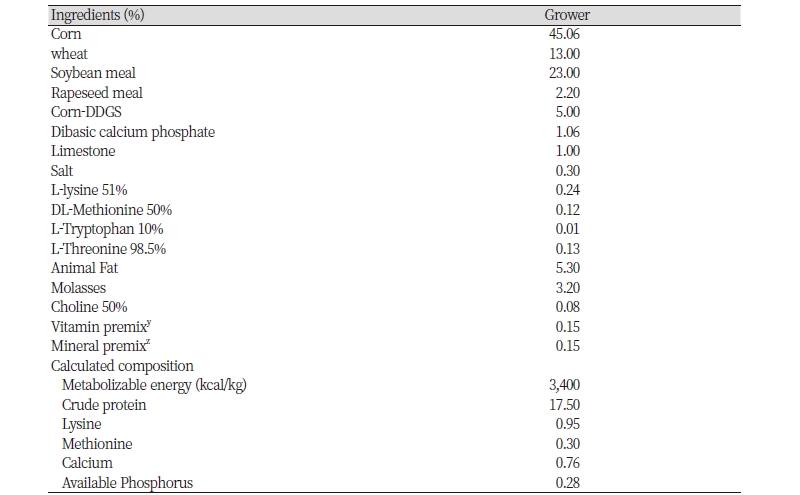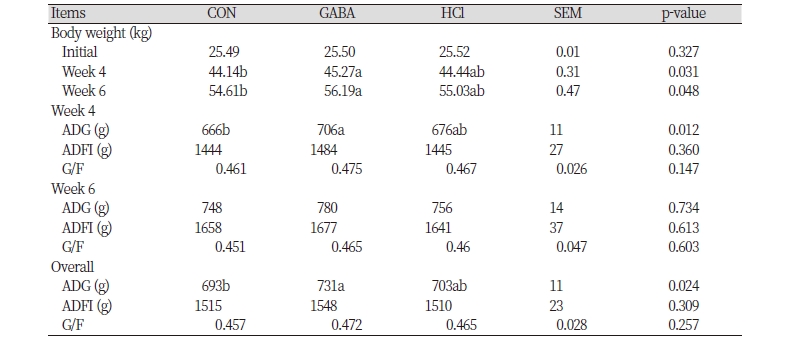Introduction
In animal production, reducing the stress of animals is one of the points that cannot be ignored in improving production performance. Stress represents the reaction of the body to stimuli that disturb its normal physiological equilibrium or homeostasis, often with detrimental effects (Khansari et al., 1990). Stress is caused due to temperature variation (cold and overheating), weaning, transfer, castration, docking, vaccination, drugs; the stress of feed nutrition; the stress of stocking density (Kelley, 1980). Stress response causes obstruction of animal growth and loss of appetite which have serious impact on animal production. According to Erdö (1985) and Bongianni et al. (2006) studies, γ-aminobutyric acid (GABA) has the physiological functions of sedation, hypnosis, anti-convulsion, lowering blood pressure, regulating respiration and anti-stress and one of the major inhibitory neurotransmitters in the central nervous system. Abdou et al. (2006) reported for humans, GABA not only relaxes but also reduces anxiety. Moreover, GABA administration is able to enhance immunity under stress conditions. Data from animal studies suggested that decreased GABA levels in the brain are associated with anxiety-like behavior (Dalvi and Rodgers, 2001; Shekhar et al., 2006). Dai et al. (2011) reported the diet supplemented with GABA increased weight gain and feed consumption by 11.7 and 9.0% in broilers. Wang et al. (2013) suggested that GABA exhibits its functions by lowering heat production, relieving fever, sedation and better for growth in dairy cows.
The growth of animals needs to be carried out by feeding fodder, and the digestion and metabolism of fodder are carried out by the digestive system. The functions of the stomach include feed mixing, digestion of some feed and form a barrier with the outside environment (Barrow et al., 1977; Zhang and Xu, 2003). For digestion, the stomach is endowed with hydrochloric acid (HCl) secreting cells that help to keep its pH low and forming an acid environment can kill pathogenic microorganisms (Lewis and Southern, 2000). Ravindran and Kornegay (1993) and Kil et al. (2005) reported that supplementation of hydrochloric acid to the feed can increase the nitrogen retention and improve the apparent digestibility of nitrogen, and can activate pepsin, promoting digestions. It is reported that an acid condition of less than pH 4.5 prevents the growth of many bacteria, prevent diarrhea in weaning pigs in an in-vitro study (Sissons, 1989). The hypothesis of this study is that GABA and HCl supplementation may reduce stress and improve performance of animals.
From the study of γ-aminobutyric acid and hydrochloric acid, there are many advantages, this test will further verify the growth, digestibility and fecal index of growing pigs, providing more valuable research.
Materials and methods
Animals and experimental diets
In total 90 pigs of Duroc × (Landrace × Yorkshire) were approved by the Animal Care and Use Committee of Dankook University, with an average 25.51 ± 1.63 kg were selected and randomly allotted to three treatment groups with 6 replications of 5 pig per replicate pen for each treatment. The experiment treatments were as follows: 1) control, basal diet (CON); 2) 0.05% γ-aminobutyric acid, basal diet with 0.05% GABA; 3) 1% HCl (10%), basal diet with 1% HCl (10%). The diets were based on the nutrient requirements recommended by NRC (2012) (Table 1). The γ-aminobutyric acid used in the current experiment was provided by a commercial company (Milae Resources ML Co., Ltd., Korea), and hydrochloric acid was obtained from (Duksan pure chemicals Co., Ltd., Korea)
Animal feeling and management
Pigs were raised in a pen equipped with a self-feeder and a nipple drinker in Dankook University (Cheonan, Korea) farm. The additives were directly added to the basal diet according to the experimental design. Pigs were housed in environmentally controlled rooms at 23 ± 1℃, each pen provided a self-feeder and nipple drinker. Pigs were provided to consume feed and water ad libitum. The experiment was conducted for six weeks, with daily cleaning and immunization procedures.
Sampling and chemical analysis
The individual body weight (BW) of pigs and feed consumption from each pen were determined at the start, week 4 and week 6 of the experiment to calculate the average daily gain (ADG), average daily feed intake (ADFI), and gain : feed ratio (G/F). Chromium oxide (Cr2O3) was added to the diet at 0.2% of the diet as an indigestible marker for 7 days prior to fecal collection on weeks 6 to calculate dry matter (DM), nitrogen (N) and energy. The fecal score was determined as the average value of five pigs of each pen using a 5-grade score system (Hu et al., 2012), with grade of 1 standing for hard, dry pellets in a small, hard mass, grade of 2 for hard formed stool that remains firm and soft, grade of 3 for soft formed and moist stool that retains its shape, grade of 4 for soft unformed stool that assumes the shape of the container, and grade of 5 for watery liquid stool that can be poured. Scores were recorded on a pen basis following the observations of individual pig and signs of stool consistency in each pen every week.
Data analysis
All data obtained in the current study were analyzed in accordance with a completely randomized block design using the GLM procedure of SAS (SAS Institute, 1996). Duncan's multiple range test was used to compare the means of the treatments. Variability in the data is expressed as the standard error (SE) and a probability level of p < 0.05 was considered statistically significant.
Results
Growth performance
No piglets were found dead because of diseases or other reasons throughout the experiment. The effect of GABA or HCl supplementation on growth performance is presented in Table 2. The average daily gain of GABA was significantly higher than group CON (p < 0.05) during week 4 as well as during overall experimental period. The ADG was numerically higher for pigs receiving HCl supplemented diet compared with control.
Nutrient digestibility
The effects of GABA and HCl on total tract nutrient digestibility is shown in Table 3. The apparent total digestive tract digestibility (ATTD) of DM was greater in GABA than CON (p < 0.05). However, the ATTD of nitrogen (N) and energy were unaffected with GABA supplementation as compared with control. The digestibility of DM with HCl supplementation was slightly higher than that of control group (p > 0.05).
Fecal score
The effect of GABA and HCl on fecal score is shown in Table 4. The supplementation of GABA and HCl in the diet of growing pig had no significant effect on fecal scores compared with CON.
Discussion
GABA has been widely used in the production of various animals. Adding GABA to the diet of ruminants, reduced rectal temperatures, increased milk production, and enhanced milk protein and lactose concentrations (Cheng et al., 2014). From Chen et al. (2015) study, adding GABA in Wen Chang chicken diet, increased BW, ADG, and FCR (feed conversion ratio). After the brain of rats was injected with GABA excitatory receptors, increased the amount of intake (Stratford and Kelley, 1999). GABA also promotes the secretion of gastrin, digestion and absorption, improves the amount of feed intake, and can also promote the secretion of growth hormone thereby promoting growth (Krantis and Kerr, 1981; Piqueras and Martinez, 2004). Zou et al. (2009) and Fan et al. (2007) reported that GABA supplement to growing pigs and finishing pigs can also improve growth performance and ADG, which is consistent with the results of this experiment. The results about Zou’s supplementation of 0.001% GABA (10 mg/kg) increased the growth-finishing pigs FCR. And Fan’s supplementation of 0.01% GABA (100 mg/kg) increased in ADFI of growing pigs. Nevertheless, Wei et al. (2004) demonstrated that supplementation of 0.04% GABA (400 mg/kg) failed to promote feed intake, there was no significant difference in the ADFI and FCR of this experiment with supplementation of 0.05% GABA (500 mg/kg). No change in dietary intake may be related to the addition of GABA dose, which was similar with the conclusion of 0.05% GABA in this study. It may also be due to the environment, temperature, breed of pig and the company producing the additive at the time of the experiment, which needs to be verified by more experiments. Although (Giesting and Easter, 1986), noted that inorganic acidifier has been generally considered to have negative effect on growth performance in weaning pigs by compromising feed intake, from the influence of HCl on growth performance. In this experiment, although supplementation of HCl was different from that of the control group, the difference was not significant, which is consistent with the results reported by (Kil et al., 2005). It may be that the effect of HCl on the growth of piglets gradually decreases with age, and the specific effect remains to be further studied.
In terms of nutrient digestion and metabolism, GABA had effect on the digestion and metabolism of DM compared with the control group, but there were no significant differences between nitrogen and energy, this was consistent with the results of Zhang et al. (2018) experiment in which 0.05% GABA was added to finishing pigs. Maybe supplemental GABA had no effect on N and energy, more prove this suggestion in further. According to Chen et al. (2014), the application of GABA against high-temperature stress in chickens had more effects on digestive enzymes. HCl in this experiment had effect on the digestibility of growing pigs, but the effect was not significant compared with the control group, which may be related to the feeding conditions or the breed of pigs.
Results from the present study, performed with growing pigs, GABA and HCl showed no effect on the fecal score. Diarrhea is a serious problem which is related to the intestinal microflora for weaning pigs (Xu et al., 2018). GABA and HCl supplemented in the diet certainly warrant further research given the emphasis on antibacterial resistance and reduced antimicrobial use in animal agriculture now.








